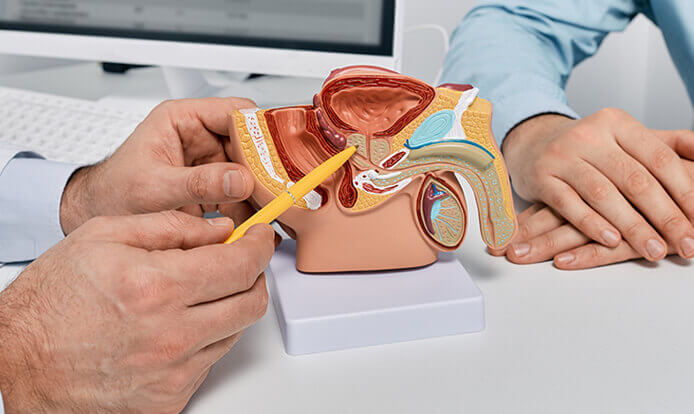Enlarged Prostate (BPH)

Medically reviewed by Dr Michael Wong, Medical Director & Senior Consultant Urologist
FAMS (Urology), FICS (USA), FRCS (Edinburgh), M Med (Surgery), MBBS (S’pore)

What Is Benign Prostatic Hyperplasia (BPH)?
What Are the Symptoms of an Enlarged Prostate?
The symptoms of an enlarged prostate are typically mild at first, but they can worsen over time without treatment. Some common symptoms include:

Dribbling at the end of urination

Difficulty starting urination

Straining to urinate

A feeling of not fully emptying the bladder

Repeatedly urinating at night (nocturia)

Urinary incontinence

Presence of blood in the urine (haematuria)

Discomfort or pain during urination

Risk Factors for Prostate Enlargement

Older age, commonly seen in men over the age of 50

A family history of prostate issues

Hormonal changes, particularly testosterone and dihydrotestosterone (DHT)

Certain medical conditions like heart disease, diabetes, or erectile dysfunction

Being overweight and leading a sedentary lifestyle
Possible Complications of An Enlarged Prostate
Acute Urinary Retention
Urinary Tract Infections
Bladder Stones
Kidney Damage
How is Prostate Enlargement Diagnosed?
Digital Rectal Examination
Urine Flow Test (Uroflowmetry)
Post-Void Residual Volume Test
Urinalysis
Cystoscopy
Prostate-Specific Antigen (PSA) Test
Treatments for Benign Prostatic Hyperplasia (BPH)

Medications
A doctor typically prescribes medications as the first line of treatment to help manage symptoms. These include:
Alpha-blockers
- These medications improve urinary flow by relaxing the muscles in the prostate and bladder.5-Alpha Reductase Inhibitors
- These drugs inhibit the production of dihydrotestosterone to help shrink excess prostate tissue and relieve symptoms.
Minimally Invasive Procedures
If medication does not relieve the patient's symptoms, the doctor may consider minimally invasive techniques, such as:
Water Vapour Therapy
- This procedure involves inserting sterile water vapour using a cystoscope into the prostate gland to ablate (remove) excess prostate tissue.Prostatic Urethral Lift (PUL)
- This treatment involves placing small, permanent implants to lift and hold the prostate lobes apart and widen the urethra passage for improved urine flow.Transurethral Microwave Thermotherapy (TUMT)
- This technique employs microwave heating to destroy prostate tissue allowing urine to pass through.
Surgical Procedures
In severe cases, the doctor may perform a surgical procedure to remove excess prostate tissues.
Transurethral Resection of the Prostate (TURP)
- This surgery involves inserting a resectoscope with a wire loop through the urethra to remove the obstructing prostate tissue in small sections.Laser Prostatectomy
- This procedure uses high-powered laser energy, delivered through a thin cystoscope tube, to destroy overgrown prostatic tissue.Transurethral Incision of the Prostate
- Unlike TURP, this procedure does not remove the prostate tissue. Instead, a small incision is made in the prostate and bladder neck to minimise pressure on the urethra and allow easier urine passage.
FAQs About Enlarged Prostate
Will BPH impact my daily life?
Is drinking lots of water enough to prevent prostate enlargement?
Is BPH the same as prostate cancer?
Let us help you
Restore your urological health.
Make an appointment with Dr Michael Wong to receive a tailored, supportive and targeted care plan.
Office
Location
3 Mount Elizabeth Road, #10-09,
Mount Elizabeth Medical Centre,
Singapore 228510
Contact
Number
| Tel | |
| Tel | |
| Fax | : (65) 6838 1216 |
| 24-hour answering service |
Email
Address
Opening
Hours
Mon-Fri | : 9:00am - 1:00pm |
Sat | : 9:00am - 12:00pm |
Sun/PH | : Closed |





